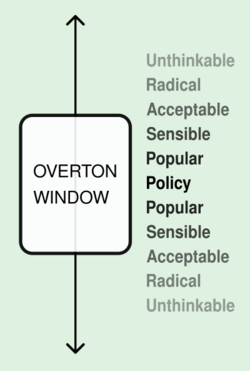Social:Overton window
The Overton window is the range of policies politically acceptable to the mainstream population at a given time.[1] It is also known as the window of discourse.
Background
The term is named after the American policy analyst Joseph Overton, who proposed that an idea's political viability depends mainly on whether it falls within this range, rather than on politicians' individual preferences.[2][3] According to Overton, the window frames the range of policies that a politician can recommend without appearing too extreme to gain or keep public office given the climate of public opinion at that time.
Summary
Overton described a spectrum from "more free" to "less free" with regard to government intervention, oriented vertically on an axis, to avoid comparison with the left/right political spectrum.[4] As the spectrum moves or expands, an idea at a given location may become more or less politically acceptable. After Overton's death, his Mackinac Center for Public Policy colleague Joseph Lehman further developed the idea and named it after Overton.[5]
The political commentator Joshua Treviño has postulated that the six degrees of acceptance of public ideas are roughly:[6]
- Unthinkable
- Radical
- Acceptable
- Sensible
- Popular
- Policy
The Overton window is an approach to identifying the ideas that define the spectrum of acceptability of governmental policies. It says politicians can act only within the acceptable range. Shifting the Overton window involves proponents of policies outside the window persuading the public to expand the window. Proponents of current policies, or similar ones within the window, seek to convince people that policies outside it should be deemed unacceptable. According to Lehman, who coined the term,
| “ | The most common misconception is that lawmakers themselves are in the business of shifting the Overton window. That is absolutely false. Lawmakers are actually in the business of detecting where the window is, and then moving to be in accordance with it.[5] | ” |
According to Lehman, the concept is just a description of how ideas work, not advocacy of extreme policy proposals. In an interview with The New York Times , he said
| “ | It just explains how ideas come in and out of fashion, the same way that gravity explains why something falls to the earth. I can use gravity to drop an anvil on your head, but that would be wrong. I could also use gravity to throw you a life preserver; that would be good.[7] | ” |
Criticism
Laura Marsh of The New Republic argued that:
| “ | Viewing politics through the Overton Window reinforces liberal notions about the moderate center, even as that center ground erodes. ... Overton did little more than repackage the basic negotiating principle that if you ask for a lot, you will likely get more than if you ask for a little.[8] | ” |
See also
References
- ↑ Giridharadas, Anand (21 November 2019). "How America's Elites Lost Their Grip". Time (magazine). https://time.com/5735384/capitalism-reckoning-elitism-in-america-2019/. Retrieved 22 November 2019.
- ↑ "Joseph P. Overton". Mackinac Center for Public Policy. http://www.mackinac.org/bio.aspx?ID=12.
- ↑ "A Brief Explanation of the Overton Window". Mackinac Center for Public Policy. http://www.mackinac.org/12887.
- ↑ Lehman, Joseph G. (23 November 2009). "Glenn Beck Highlights Mackinac Center's "Overton window"". Mackinac Center for Public Policy. http://www.mackinac.org/11398.
- ↑ 5.0 5.1 Robertson, Derek (25 February 2018). "How an Obscure Conservative Theory Became the Trump Era's Go-to Nerd Phrase". Politico. https://www.politico.com/magazine/story/2018/02/25/overton-window-explained-definition-meaning-217010.
- ↑ Treviño, Joshua (29 April 2006). "The Overton window.". http://www.swordscrossed.org/?p=50.
- ↑ Astor, Maggie (26 February 2019). "How the Politically Unthinkable Can Become Mainstream". The New York Times. https://www.nytimes.com/2019/02/26/us/politics/overton-window-democrats.html.
- ↑ Marsh, Laura (27 October 2016). "The Flaws of the Overton Window Theory". The New Republic. https://newrepublic.com/article/138003/flaws-overton-window-theory.
Further reading
- Pilgrim, Mark (23 August 2006). "W3C and the Overton window". Dive into Mark. http://diveintomark.org/archives/2006/08/23/overton-window.
- Lehman, Joseph G. (8 April 2010). "An Introduction to the Overton Window of Political Possibility". Mackinac Center for Public Policy. http://www.mackinac.org/12481.
- Astor, Maggie (26 February 2019). "How the Politically Unthinkable Can Become Mainstream". The New York Times. https://www.nytimes.com/2019/02/26/us/politics/overton-window-democrats.html.
- Beck, Glenn (2010). The Overton Window. Simon and Schuster. ISBN 978-1-4391-9011-1.
- Bobric, George-Daniel (2021). "The Overton Window: A Tool for Information Warfare". in Lopez, Juan; Perumalla, Kalyan; Siraj, Ambareen. ICCWS 2021 16th International Conference on Cyber Warfare and Security. Academic Conferences Limited. pp. 20–27. ProQuest 2505729645. ISBN 978-1-912764-88-4. https://books.google.com/books?id=BpgjEAAAQBAJ&pg=PA20.
- Zbigniew Szałek, Benon (31 January 2013). "Some Praxiological Reflections on the So-Called 'Overton Window of Political Possibilities','Framing' and Related Problems". Reality of Politics 4 (1): 237–257. doi:10.15804/rop201315.
- Morgan, Daniel J (23 May 2020). "The Overton Window and a Less Dogmatic Approach to Antibiotics". Clinical Infectious Diseases 70 (11): 2439–2441. doi:10.1093/cid/ciz984. PMID 31605478.
- Talbot, George H (23 May 2020). "Widening the Overton Window—While Avoiding Defenestration". Clinical Infectious Diseases 70 (11): 2442–2443. doi:10.1093/cid/ciz990. PMID 31605475.
- Krick, Jeanne A.; Feltman, Dalia M.; Carter, Brian S. (17 August 2023). "Buy-in and breakthroughs: the Overton window in neonatology for the resuscitation of extremely preterm infants". Journal of Perinatology. doi:10.1038/s41372-023-01755-9. PMID 37591944.
- Dyjack, David (March 2020). "The Overton Window". Journal of Environmental Health 82 (7): 54. ProQuest 2366486194.
- The Lancet Planetary Health (November 2021). "Moving the Overton window". The Lancet Planetary Health 5 (11): e751. doi:10.1016/S2542-5196(21)00293-X. PMID 34774112.
- Dustin, Moira; Ferreira, Nuno; Millns, Susan (2019). "Conclusion: Brexit, Gender Justice and the Overton Window". Gender and Queer Perspectives on Brexit. Gender and Politics. pp. 463–472. doi:10.1007/978-3-030-03122-0_18. ISBN 978-3-030-03121-3. https://osf.io/4tf3g/.
 |


